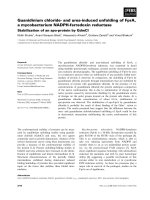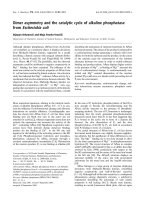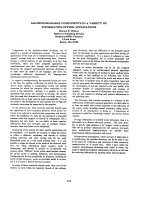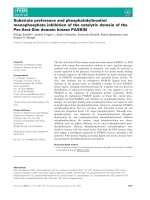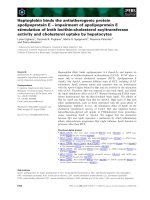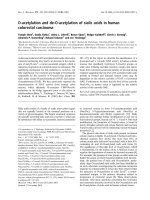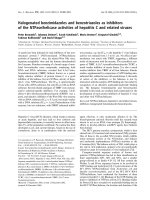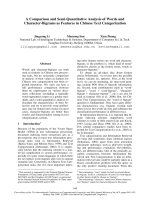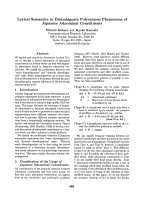Báo cáo khoa học: Megalin binds and mediates cellular internalization of folate binding protein potx
Bạn đang xem bản rút gọn của tài liệu. Xem và tải ngay bản đầy đủ của tài liệu tại đây (354.07 KB, 8 trang )
Megalin binds and mediates cellular internalization of
folate binding protein
Henrik Birn
1
, Xiaoyue Zhai
1
, Jan Holm
2
, Steen I. Hansen
2
, Christian Jacobsen
3
, Erik I. Christensen
1
and Søren K. Moestrup
3
1 Department of Cell Biology, Institute of Anatomy, University of Aarhus, Denmark
2 Department of of Clinical Chemistry, Hillerød Hospital, Denmark
3 Department of Medical Biochemistry, University of Aarhus, Denmark
Folate is a vitamin involved in essential biological
processes such as the synthesis of nucleic acid and
the metabolism of amino acids. Humans are unable
to synthesize this vitamin and thus rely on intestinal
reabsorption. Distribution into tissues thereafter is
dependent on specific uptake mechanisms involving
the reduced folate carrier and ⁄ or the 30–40 kDa
folate binding proteins (FBPs) [1–3]. At least three
isoforms of FBPs have been identified including both
glycosylphosphatidylinositol (GPI)-linked, membrane
associated folate receptors highly expressed in certain
epithelial tissues and soluble proteins present in
serum and other biological fluids [1,2] including the
secretory fluids: milk, saliva, and semen [4–9]. The
significance of the soluble folate binders is largely
unresolved, but it has been suggested that milk FBP
may play a role in folate uptake [2], i.e. by protect-
ing against oxidation, by promoting folate absorption
in the suckling animal [10–12], or protect against
bacterial utilization of secreted folates [13]. Based on
Keywords
absorption; endocytosis; intestine; kidney;
vitamins
Correspondence
H. Birn, Department of Cell Biology,
Institute of Anatomy, University of Aarhus,
University Park Building 234, DK-8000
Aarhus C, Denmark
Fax: +45 86198664
Tel: +45 89423051
E-mail:
(Received 15 March 2005, revised 4 July
2005, accepted 11 July 2005)
doi:10.1111/j.1742-4658.2005.04857.x
Folate is an essential vitamin involved in a number of biological processes.
High affinity folate binding proteins (FBPs) exist both as glycosylphospha-
tidylinositol-linked, membrane associated folate binding proteins and as
soluble FBPs in plasma and some secretory fluids such as milk, saliva and
semen. The function and significance of FBPs are unresolved, however, it
has been suggested that they may facilitate folate uptake, e.g. during suck-
ling. The present study shows that megalin, a large, multiligand endocytic
receptor and member of the low-density lipoprotein-receptor family, is able
to bind and mediate cellular uptake of FBP. Surface plasmon resonance
analysis shows binding of bovine and human milk FBP to immobilized
megalin, but not to low density lipoprotein receptor related protein. Bind-
ing of
125
I-labeled folate binding protein (FBP) to sections of kidney proxi-
mal tubule, known to express high levels of megalin, is inhibitable
by excess unlabeled FBP and by receptor associated protein, a known
inhibitor of binding to megalin. Immortalized rat yolk sac cells, represent-
ing an established model for studying megalin-mediated uptake, reveal
125
I-labeled FBP uptake which is inhibited by receptor associated protein
and by antimegalin antibodies. Microinjection of
125
I-labeled FBP into
renal tubules in vivo shows proximal tubular uptake by endocytosis.
Megalin is expressed in several absorptive epithelia, including intestine and
kidney proximal tubule, and thus the present findings provide a mechanism
for intestinal and renal endocytic uptake of soluble FBP.
Abbreviations
5-MTHF, 5-methyltetrahydrofolate; CPM, counts per minute; FBP, folate binding protein; GPI, glycosylphosphatidylinositol; LRP, low-density
lipoprotein receptor related protein; RAP, receptor associated protein.
FEBS Journal 272 (2005) 4423–4430 ª 2005 FEBS 4423
studies of folate-FBP uptake in suckling rats it was
suggested that intestinal uptake of FBP-bound folate
resembles the endocytic absorption of other macro-
molecules in the neonate intestine [12], however, the
mechanism of this process has not been identified.
We have previously characterized different receptors
involved in the endocytic uptake of proteins and
nutrients in the kidney and other tissues [14]. Meg-
alin, an 600 kDa member of the low-density
lipoprotein-receptor family [15], is a multiligand,
endocytic receptor expressed in a number of absorp-
tive epithelia including kidney, yolk sac, choroid
plexus, and intestine [14,16,17]. So far more than 40
different ligands have been identified representing a
wide variety of substance including lipoproteins, hor-
mones, carrier proteins, enzymes, and drugs. Megalin
is involved in the endocytic uptake of a number of
vitamin carrier proteins [18], including retinol binding
protein [19], transcobalamin [20], and vitamin D
binding protein [21,22] and its role for the recovery
of vitamins and carrier proteins filtered in the renal
glomerulus is well established [18,23]. In addition,
megalin seems important for normal expression of
the intestinal intrinsic factor-vitamin B
12
-receptor
cubilin [16,24]. Inspired by these observations we
have examined a possible interaction between FBP
and megalin. The presented data shows that megalin
is able to bind and mediate the endocytosis of
soluble FBP providing a potential mechanism for
intestinal and renal uptake of soluble FBP-bound
folate.
Results
Megalin binds FBP
Surface plasmon resonance analysis showed binding of
purified, human and bovine milk apo-FBP to immo-
bilized rabbit megalin. Binding was also observed
with bovine FBP saturated with folic acid, 5-methyl-
tetrahydrofolate (5-MTHF), or methotrexate (Fig. 1).
Using a biaevaluation program K
d
was estimated to
0.3–0.5 lm for apo-FBP and saturated FBP (Fig. 1).
No binding was identified to low-density lipoprotein
receptor related protein (LRP), the most closely related
member of the LDL-receptor family [25].
To confirm binding of FBP to megalin in tissues we
used autoradiography on sections of rat kidney cortex
showing very high expression of megalin in kidney
proximal tubule brush border membranes. Incubation
with
125
I-labeled human or bovine milk FBP resulted
in accumulation of autoradiographic grains along the
apical part of proximal tubule cross-sections similar to
the localization of megalin (Fig. 2). This was inhibited
by coincubation with excess unlabeled FBP or with
receptor associated protein (RAP), an established
inhibitor of the uptake of most ligands by megalin [14],
suggesting specific binding to megalin.
Endocytosis of FBP
Microinjection of
125
I-labeled bovine milk FBP in rat
kidney nephrons in vivo followed by autoradiography
A
B
Fig. 1. Binding of soluble FBP to immobilized megalin and LRP by surface plasmon resonance analysis (BIAcore). Soluble human or bovine
milk FBP purified by a combination of ion-exchange and affinity chromatography was passed over the sensor chips with immobilized, purified
megalin, or LRP and the SPR signal (RU) representing bound protein was recorded. (A) SPR sensorgram showing binding of bovine milk
apo-FBP, folic acid-FBP, 5-MTHF-FBP, and methotrexate-FBP to immobilized megalin. Using the
BIAEVALUATION program K
d
was estimated
between 0.3 and 0.5 l
M. Similar binding of human apo-FBP was observed (not shown). (B) No binding of bovine milk apo-FBP, folic acid-
FBP, 5-MTHF-FBP, or methotrexate-FBP was observed to purified LRP.
Megalin-mediated uptake of FBP H. Birn et al.
4424 FEBS Journal 272 (2005) 4423–4430 ª 2005 FEBS
revealed uptake of FBP within proximal tubule seg-
ments (Fig. 3), known to express high levels of meg-
alin. In contrast, distal nephron segments and
collecting ducts revealed no significant labeling. The
label could be identified in endocytic vesicles and vacu-
oles 15–30 min after microinjection (Fig. 3B,C).
Megalin mediates cellular uptake of FBP
Megalin expressing, rat yolk sac BN-16 cells internal-
ized human milk
125
I-labeled FBP (Fig. 4). Total
uptake was calculated as the sum of degraded, non tri-
chloroacetic acid-precipitable label and cell associated
label. The time course of uptake is comparable to pre-
vious published uptake of the vitamin B
12
carrier
transcobalamin in similar cells [20]. The total uptake
was significantly inhibited by RAP and antimegalin
antibodies, showing the involvement of megalin in
uptake. A small, however, significant inhibition with
nonspecific IgG was observed at 4 h explained by low-
affinity binding of immunoglobulin light chains to
megalin [26]. While degradation was clearly inhibited,
the cell associated amount of label was less affected
by RAP.
Discussion
FBP is present in different biological, secretory fluids,
including saliva and semen, and in particular milk
[4–9]. The significance of these folate binders is largely
unknown, but it has been suggested that milk FBP,
shown to be resistant to gastric digestion [27], may
play a role in folate uptake in the neonate intestine
[10–12]. The present study shows that megalin, a large,
Fig. 2. Autoradiography showing RAP-inhibitable binding of soluble
125
I-labeled FBP to proximal tubules of rat kidney cortex. Sections of per-
fusion fixed rat kidney cortex were incubated with
125
I-labeled human or bovine milk FBP. Binding to sections was identified by autoradiogra-
phy following 36–47 days of exposure. For inhibition studies sections were coincubated with either excess unlabeled FBP or RAP
(50 lgÆmL
)1
). Labeled bovine (A) and human (C) milk FBP is concentrated along the apical part of proximal tubule cross-sections similar to
the localization of megalin (insert , 2C). Binding to sections is inhibited by excess unlabeled bovine FBP (B, compare with A) and RAP (D,
compare with C) suggesting binding to megalin. Bars equal 10 lm.
H. Birn et al. Megalin-mediated uptake of FBP
FEBS Journal 272 (2005) 4423–4430 ª 2005 FEBS 4425
multiligand, endocytic receptor expressed in the intes-
tine and other absorptive epithelia binds and mediates
the internalization of FBP. This is based on the obser-
vations that: (a) purified bovine and human milk FBP
binds to immobilized megalin when analysed by sur-
face plasmon resonance analysis. The K
d
can be esti-
mated to 0.3 lm comparable to the affinity of
several other ligands binding to megalin; (b) milk FBP
binds to proximal tubules in sections of rat kidney
cortex known to express high levels of megalin. This
binding is inhibited by excess unlabeled FBP and by
RAP, a chaperone and known inhibitor of the uptake
of most ligands by megalin; (c) in vivo microinjection
of
125
I-labeled milk FBP into rat kidney nephrons
reveal endocytic uptake in megalin-expressing proximal
tubule cells only; (d) BN-16 cells known to express
megalin and representing an established model for
megalin-mediated uptake, internalize
125
I-labeled milk
FBP, and internalization is strongly inhibited by RAP
and antimegalin antibodies. These findings suggest a
potential role for megalin in mediating internalization
of FBP-bound folate, providing a candidate mecha-
nism for both intestinal and renal tubular uptake of
soluble FBP.
Megalin is expressed in the intestine [16,17] and
megalin-mediated endocytosis provides a mechanism
for the previously suggested [12] endocytic absorption
of FBP-bound folate during suckling. It was noted
that in contrast to free folate, FBP-bound folate
is absorbed more avidly in the ileum than in the
jejunum correlating with the observed expression of
megalin in purified apical brush-border membranes
from distal, but not proximal, rat intestine [17]. The
kinetics of FBP transport in neonatal goat intestinal
brush border have revealed that K
m
¼ 0.39 lm for
unsaturated FBP [11], comparable to our findings
using isolated proteins. Small differences in K
d
were
calculated comparing the response curves for apo-
FBP, folic acid-FBP, 5-methyltetrahydrofolate-FBP,
and methotrexate-FBP, with apo-FBP having the
highest affinity compared to saturated FBP. While
this in line with the observation of [11], the differ-
ences are small and probably within the methodological
variation associated with surface plasmon resonance
analysis.
Renal proximal tubular epithelium expresses abun-
dant megalin serving an important role mediating
reabsorption of vitamin-carrier protein complexes fil-
tered in the glomeruli thus preventing excessive urinary
loss [18,23]. These carrier complexes include retinol
binding protein [19], transcobalamin [20], and vitamin
D binding protein [21,22]. Although most folate in
plasma is filtered in the renal glomerulus as unbound
folate, a soluble FBP is present in plasma at a concen-
tration of about 0.6 nm in humans [28]. The molecular
weight of 35 kDa suggests that this protein to a
large extent is filtered, and FBP has been detected in
human urine at a concentration of 0.3 nm [29]. Assu-
ming a glomerular filtration rate of 180 L ⁄ 24 h and
urinary excretion rate of 2 L ⁄ 24 h it may be calculated
that only < 1% of the plasma FBP actually filtered in
the glomeruli is excreted suggesting efficient tubular
reabsorption. Thus, 108 nmoles or 48 lg of folate
may be recovered daily by tubular uptake of FBP
which may be important in individuals with very
low-folate intake. The present data provides a mecha-
Fig. 3. Uptake of
125
I-labeled bovine milk FBP microinjected into rat nephrons in vivo. Uptake of
125
I-labeled FBP is visualized by autoradio-
graphy on sections from fixed kidney cortex. Grains are located over proximal tubule profiles (A; PT) only revealing selective uptake in this
part of the nephron characterized by heavy expression of megalin (Fig. 2C, inset). No labeling is oberved in distal tubule profiles (A; DT).
Labeling is concentrated in the subapical part of the proximal tubule cells localized close to vacuolar structures (arrows in B) which
by electron microscopy can be identified as apical, endocytic vesicles or vacuoles (C; E). MV, microvilli. Bars equal 10 lm (A and B) and
0.5 lm(C).
Megalin-mediated uptake of FBP H. Birn et al.
4426 FEBS Journal 272 (2005) 4423–4430 ª 2005 FEBS
nism for this involving megalin-mediated endocytosis
similar to the uptake of other vitamin carrier proteins.
Free folate is reabsorbed within the renal proximal
tubule by a mechanism dependent on GPI-anchored
FBP expressed in the luminal plasma membrane of
proximal tubule cells [30,31]. However, in particular
at low plasma folate concentrations an additional
mechanism of tubular folate uptake may operate
[31]. Megalin-mediated uptake of filtered folate bound
to plasma FBP may constitute such an alternative
mechanism.
Megalin-mediated uptake of FBP in BN-16 cells
results in the degradation of FBP. Most likely folate
bound to FBP is released from the binder in the acidic
environment of the endocytic compartment followed by
transport across the vesicular membrane into the cyto-
sol. Similarly, the uptake of free folate mediated by
GPI-anchored FBPs expressed in the apical membrane
is suggested to involve binding of folate to the GPI-
linked FBPs, followed by endocytosis, release of folate
from the receptor within an internal compartment and
recycling of the receptor [32–34]. Thus, it is possible that
folate internalized either by megalin-mediated endocy-
tosis of soluble FBP or by binding of free folates to
membrane-associated folate receptors is released within
the same endocytic compartment and may be further
transported by a common pathway. However, while the
GPI-linked FBP is recycled to the plasma membrane,
FBP bound to megalin seems to be degraded.
In conclusion megalin is able to bind and internalize
soluble FBP by endocytosis providing a potential
mechanism for intestinal and renal uptake of soluble
FBP-bound folate in milk or the ultrafiltrate. Further
studies are needed to determine the importance of
folate uptake via this pathway.
Experimental procedures
Purification of proteins
High-affinity FBPs were purified from bovine and human
milk by a combination of cation exchange chromatography
and ligand (methotrexate) chromatography on a column
desorbed with a pH-gradient [9,35,36]. Bovine FBP was
purified from cow’s whey powder and consisted of 222
amino-acid residues with a molecular mass of 30 kDa based
on amino-acid composition and carbohydrate content [37].
Two FBPs were purified from Triton X-100 solubilized
human raw milk obtained from voluntary donors with their
full understanding and full consent. One desorbed at pH 5
had a molecular mass of 30 kDa based on its amino-acid
composition and sequence homology with bovine milk FBP
[9], while one desorbed at pH 3 was GPI-linked and extre-
mely hydrophobic only existing in a micellar form with
Triton X-100 [36]. Both FBPs had identical N-terminal
sequence for 39 cycles and were immunologically identical
[9,36]. The enzyme phosphatidyl inositol specific phospholi-
pase C cleaved the hydrophobic GPI residue of micellar
FBP and converted it to soluble FBP [38]. Human and
bovine milk FBP was iodinated by the chloramine-T method
[39]. Receptor associated protein, an established inhibitor of
the uptake of most ligands by megalin [14], was prepared
Fig. 4. Uptake of soluble
125
I-labeled FBP in megalin expressing
BN-16 cells (percent of total added activity). Megalin expressing,
yolk sac BN-16 epithelial cells were grown to confluence and incu-
bated with
125
I-labeled human milk FBP [9000 counts per minute
(CPM)]. Total uptake represents the sum of degraded (non-trichloro-
acetic acid-precipitable) and cell-associated activity. For inhibition
studies cells were coincubated with either RAP (1 l
M, A), sheep
anti-megalin IgG (200 lgÆmL
)1
, B), or nonspecific sheep IgG
(200 lgÆmL
)1
, B). Labeled FBP is internalized and degraded in
BN-16 cells (A). Uptake is significantly inhibited by RAP (A), and
anti-megalin IgG (B). A minor, however, significant inhibition with
nonspecific IgG was observed at 4 h. Data represent mean ± SD
of four experiments. In panel A the RAP induced difference in total
uptake was significant (P < 0.001, t-test) at all time points. In (B),
significance is indicated by * (ANOVA followed by posthoc t-test
using Bonferroni correction at each time point).
H. Birn et al. Megalin-mediated uptake of FBP
FEBS Journal 272 (2005) 4423–4430 ª 2005 FEBS 4427
and used for purification of rabbit megalin by affinity
chromatography as described [40]. LRP was purified from
solubilized human placental membranes as described [41].
Binding of milk FBP to megalin by surface
plasmon resonance analysis (SPR)
For the surface plasmon resonance analyses, the BIAcore
sensor chips (type CM5; Biosensor, Uppsala, Sweden) were
activated with a 1 : 1 mixture of 0.2 m N-ethyl-N¢-(3-dimeth-
ylaminopropyl) carbodiimide and 0.05 m N-hydroxysuccini-
mide in water according to the manufacturer. Purified
megalin or LRP were immobilized on the sensor chip in
10 mm sodium acetate, pH 4.5, and the remaining binding
sites were blocked with 1 m ethanolamine, pH 8.5. The
resulting receptor densities were in the range of 23–40 fmol
receptor per mm
2
. A control flow cell was made by perform-
ing the activation and blocking procedures and by using
immobilized receptor proteins reduced by injection of 0.5%
dithiothreitol in 6 m guanidine hydrochloride, 5 mm EDTA,
and 50 m m Tris, pH 8.0, into the flow cell. Purified FBP,
with or without the addition of 2.5 lm folic acid, 5-MTHF
or methotrexate was dissolved in 10 mm Hepes, 150 mm
NaCl, 2 mm CaCl
2
, and 0.005% Tween 20, pH 7.4. Sample
and running buffers were identical. The regeneration of sen-
sor chips after each analysis cycle was performed with 1.6 m
glycine-HCl buffer, pH 3.0. The BIAcore response is
expressed in relative response units and represents the bind-
ing response using the native receptor corrected for the
response registered with the control flow cell. K
d
for binding
was estimated using a biaevaluation program.
Binding of milk
125
I-labeled FBP to tissue
cryosections
Binding of FBP to megalin in tissue was studied by auto-
radiography on 1 lm cryosections of rat kidney cortex, fixed
in 4% (v ⁄ v) paraformaldehyde in 0.1 m sodium cacodylate
buffer, pH 7.4, by retrograde perfusion through the abdom-
inal aorta. Sections were cut at 190–200 K using a Reichert
Ultracut S cryoultramicrotome and placed on gelatin coated
glass slides, preincubated in 0.01 m NaCl ⁄ P
i
, 0.05 m glycine,
0.15 m NaCl, 0.1% (w ⁄ v) skimmed milk and 0.02 m NaN
3
and incubated with
125
I-labeled human or bovine milk FBP
(2Æ 10
6
CPMÆmL
)1
) in 0.01 m NaCl ⁄ P
i
, 0.05 m Tris buffer,
0.15 m NaCl, 1 mm CaCl
2
, 0,1% BSA and 0.02 NaN
3
. For
inhibition studies excess unlabeled bovine milk FBP (10 lm)
or receptor associated protein (RAP, 1.2 lm), was added to
the
125
I-labeled FBP incubation buffer. Sections were
washed, fixed in 1% (v ⁄ v) glutaraldehyde in 0.1 m sodium
cacodylate buffer, pH ¼ 7.4 and prepared for light micro-
scope autoradiography using Ilford emulsion. After 8 days
of exposure the sections were developed and observed in a
Leica LMR microscope (Wetzlar, Germany).
Uptake of FBP in kidney proximal tubule and
cultured yolk sac cells
To study uptake
125
I-labeled bovine milk FBP was micro-
injected into kidney proximal tubules from anaesthetized
male Wistar rats (207–237 g) placed on a thermostatically
controlled heated table. A tracheostomy was performed,
and the jugular vein was catherized and infused with saline,
3.8 mLÆh
)1
. The left kidney was exposed by flank incision,
placed in a stabilized cup and covered with paraffin oil
maintained at 37–38 °C. Single surface proximal tubules
were injected with 52 nL of
125
I-labeled FBP in 0.15 m
NaCl, 1 mm CaCl
2
and lissamine green and fixed by micro-
injection of 1% glutaraldehyde 15–30 min after microinjec-
tion with
125
I-labeled FBP. Small tissue blocks containing
the microinfused tubules were postfixed, dehydrated and
embedded into Epon 812. Sections were processed for light
microscope or electron microscope autoradiography using
Ilford emulsion K2 or L4, respectively, and observed in a
Leica LMR microscope or Philips EM208 or CM100 elec-
tron microscope (Eindhoven, the Netherlands). All animal
experiments were carried out to minimize pain and discom-
fort and in accordance with the provisions for the animal
care license provided by the Danish National Animal
Experiments Inspectorate.
In addition, megalin-mediated uptake was studied in a rat
yolk sac BN-16 epithelial cell-line previously shown to
express megalin and representing an established model for
megalin-mediated uptake [19,20,42]. Cells were grown to
confluence in 24 well cell culture plates using RPMI 1640
medium (Life Technologies, Gaithersburg, MD, USA) with
5% (v ⁄ v) fetal bovine serum, 50 UÆmL
)1
penicillin, and
50 lgÆmL
)1
streptomycin (Bio-Whittaker, Wokingham,
UK). At confluence cells were incubated with
125
I-labeled
human milk FBP ( 9000 CPM) in 0.5 mL RPMI 1640 with
0.1% fetal bovine serum at 37 °C. Following 2, 4 or 8 h incu-
bation, the medium was recovered, cells were washed once in
warm medium, and harvested by trypsinization for 20 min.
An equal volume of 1% (w ⁄ v) BSA solution was added to
the collected medium along with the washing medium and
followed by precipitation with 10% (v ⁄ v) trichloroacetic
acid. The activity of the precipitate, the supernatant, and the
cells was counted separately in a Packard Cobra 5002
gamma-counter. The degraded amount of
125
I-labeled FBP
in the medium was estimated as non-trichloroacetic acid pre-
cipitated activity in the medium corrected for the non-trichlo-
roacetic acid precipitated activity in the medium of wells
incubated for the same time without cells. Total uptake of
125
I-labeled FBP was calculated as the sum of cell associated
activity and degraded
125
I-labeled FBP in the medium and
expressed in percent of total activity added. For inhibition
studies cells were coincubated with either RAP (1 lm),
purified sheep anti-rat megalin IgG (200 lgÆmL
)1
[43]), or
purified, nonspecific sheep IgG (200 lgÆmL
)1
, DAKO,
Megalin-mediated uptake of FBP H. Birn et al.
4428 FEBS Journal 272 (2005) 4423–4430 ª 2005 FEBS
Denmark). Antibodies were purified by protein A-agarose
affinity chromatography according to manufacturer’s
instructions (Pierce, Rockford, IL, USA). Data represent
mean ± SD of four experiments, and statistical analysis was
performed using unpaired t-test or ANOVA.
Immunocytochemistry
Normal Wistar rats were fixed by retrograde fixation
through the abdominal aorta using 4% (v ⁄ v) paraformalde-
hyde. For light microscope immunocytochemistry semithin
cryosections were cut as described above. Sections were
incubated 1 h with polyclonal sheep anti-rat megalin IgG
(1 : 50 000 [43]), in 10 mm NaCl ⁄ P
i
, 0.15 m NaCl, 0.1%
skimmed milk and 20 mm NaN
3
, followed by HRP-conju-
gated goat anti-sheep IgG, and visualization by incubation
with diaminobenzidine and 0.03% (v ⁄ v) H
2
O
2
for 10 min.
All incubations were performed at room temperature and
sections were counterstained with Meiers before examina-
tion in the light microscope as described above.
Acknowledgements
The work was supported in part by the Danish Medical
Research Council, the University of Aarhus, the
NOVO-Nordisk Foundation, Fonden til Lægevidenska-
bens Fremme, the Biomembrane Research Center, and
the Birn-Foundation. The skillful technical assistance by
Pia K. Nielsen, Hanne Sidelmann, and Inger Kristoffer-
sen is greatly appreciated. The study was in part presen-
ted at the ASN Annual Meeting, Philadelphia, PA,
November 1–4, 2002 and at the 13th International Sym-
posium on Chemistry & Biology of Pteridines & Folates,
Egmond aan Zee, the Netherlands, June 20–24, 2005,
and published in part as abstract.
References
1 Antony AC (1996) Folate receptors. Annu Rev Nutr 16,
501–521.
2 Henderson GB (1990) Folate-binding proteins. Annu
Rev Nutr 10, 319–335.
3 Matherly LH & Goldman DI (2003) Membrane trans-
port of folates. Vitam Horm 66, 403–456.
4 Ghitis J (1967) The folate binding in milk. Am J Clin
Nutr 20, 1–4.
5 Salter DN, Ford JE, Scott KJ & Andrews P (1972) Iso-
lation of the folate-binding protein from cow’s milk by
the use of affinity chromatography. FEBS Lett 20, 302–
306.
6 Selhub J, Arnold R, Smith AM & Piccano MF (1984)
Milk folate binding protein (FBP): a secretory protein
for folate? Nutr Res 4, 181–187.
7 Verma RS & Antony AC (1992) Immunoreactive
folate-binding proteins from human saliva. Isolation
and comparison of two distinct species. Biochem J 286,
707–715.
8 Holm J, Hansen SI & Høier Madsen M (1991) A high-
affinity folate binding protein in human semen. Biosci
Report 11, 237–242.
9 Svendsen I, Hansen SI, Holm J & Lyngbye J (1982)
Amino acid sequence homology between human and
bovine low molecular weight folate binding protein iso-
lated from milk. Carlsberg Res Comnun 47 , 371–376.
10 Colman N, Hettiarachchy N & Herbert V (1981) Detec-
tion of a milk factor that facilitates folate uptake by
intestinal cells. Science 211, 1427–1429.
11 Salter DN & Blakeborough P (1988) Influence of
goat’s-milk folate-binding protein on transport of
5-methyltetrahydrofolate in neonatal-goat small
intestinal brush-border-membrane vesicles. Br J Nutr
59, 497–507.
12 Mason JB & Selhub J (1988) Folate-binding protein
and the absorption of folic acid in the small intestine of
the suckling rat. Am J Clin Nutr 48, 620–625.
13 Ford JE (1974) Some observations on the possible nutri-
tional significance of vitamin B12-and folate-binding
proteins in milk. Br J Nutr 31, 243–257.
14 Christensen EI & Birn H (2002) Megalin and cubilin:
multifunctional endocytic receptors. Nat Rev Mol Cell
Biol 3, 256–266.
15 Saito A, Pietromonaco S, Loo AK & Farquhar MG
(1994) Complete cloning and sequencing of rat
gp330 ⁄ ’megalin’, a distinctive member of the low density
lipoprotein receptor gene family. Proc Natl Acad Sci
USA 91, 9725–9729.
16 Birn H, Verroust PJ, Nexø E, Hager H, Jacobsen C,
Christensen EI & Moestrup SK (1997) Characterization
of an epithelial 460 kDa protein that facilitates endocy-
tosis of intrinsic factor-vitamin B
12
and binds receptor-
associated protein. J Biol Chem 272, 26497–26504.
17 Yammani RR, Seetharam S & Seetharam B (2001)
Cubilin and megalin expression and their interaction in
the rat intestine: effect of thyroidectomy. Am J Physiol
Endocrinol Metab 281, E900–E907.
18 Christensen EI & Willnow TE (1999) Essential role of
megalin in renal proximal tubule for vitamin homeo-
stasis. J Am Soc Nephrol 10, 2224–2236.
19 Christensen EI, Moskaug JO, Vorum H, Jacobsen C,
Gundersen TE, Nykjær A, Blomhoff R, Willnow TE &
Moestrup SK (1999) Evidence for an essential role of
megalin in transepithelial transport of retinol. J Am Soc
Nephrol 10, 685–695.
20 Moestrup SK, Birn H, Fischer PB, Petersen CM,
Verroust PJ, Sim RB, Christensen EI & Nexø E (1996)
Megalin-mediated endocytosis of transcobalamin-vita-
min-B
12
complexes suggests a role of the receptor in
H. Birn et al. Megalin-mediated uptake of FBP
FEBS Journal 272 (2005) 4423–4430 ª 2005 FEBS 4429
vitamin-B
12
homeostasis. Proc Natl Acad Sci USA 93,
8612–8617.
21 Nykjær A, Dragun D, Walther D, Vorum H, Jacobsen C,
Herz J, Melsen F, Christensen EI & Willnow TE (1999)
An endocytic pathway essential for renal uptake and acti-
vation of the steroid 25-(OH) vitamin D
3
. Cell 96, 507–
515.
22 Nykjær A, Fyfe JC, Kozyraki R, Leheste JR, Jacobsen
C, Nielsen MS, Verroust PJ, Aminoff M, Chapelle A,
Moestrup SK, Ray R, Gliemann J & Christensen EI
(2001) Cubilin dysfunction causes abnormal metabolism
of the steroid hormone 25-(OH) vitamin D
3
. Proc Natl
Acad Sci USA 98, 13895–13900.
23 Christensen EI & Birn H (2001) Megalin and cubilin:
synergistic endocytic receptors in renal proximal tubule.
Am J Physiol Renal Physiol 280, F562–F573.
24 Moestrup SK, Kozyraki R, Kristiansen M, Kaysen JH,
Rasmussen HH, Brault D, Pontillon F, Goda FO,
Christensen EI, Hammond TG & Verroust PJ (1998)
The intrinsic factor-vitamin B12 receptor and target of
teratogenic antibodies is a megalin-binding peripheral
membrane protein with homology to developmental
proteins. J Biol Chem 273, 5235–5242.
25 Willnow TE, Nykjaer A & Herz J (1999) Lipoprotein
receptors: new roles for ancient proteins. Nat Cell Biol
1, E157–E162.
26 Birn H, Lebeolleux M, Moestrup SK, Ronco P, Aucou-
turier P & Christensen EI (2002) Receptor mediated
uptake of light chains in kidney proximal tubules. In
Monoclonal Gammapathies and the Kidney (Aucouturier
P, Hermine P, Ronco P & Touchard G, eds). Klu
¨
wer,
the Netherlands.
27 Salter DN & Mowlem A (1983) Neonatal role of milk
folate-binding protein: studies on the course of digestion
of goat’s milk folate binder in the 6-d-old kid. Br J Nutr
50, 589–596.
28 Holm J, Hansen SI & Lyngbye J (1980) High-affinity
binding of folate to a protein in serum of male subjects.
Clin Chim Acta 100, 113–119.
29 Hansen SI, Holm J & Lyngbye J (1980) High-affinity
protein binding of folate in urine. IRCS Med Sci 8,
846–847.
30 Selhub J, Emmanouel D, Stavropoulos T & Arnold R
(1987) Renal folate absorption and the kidney
folate binding protein. I. Urinary clearance studies.
Am J Physiol 252, F750–F756.
31 Birn H, Spiegelstein O, Christensen E, I & Finnell RH
(2005) Renal tubular reabsorption of folate mediated
by folate binding protein 1. J Am Soc Nephrol 16,
608–615.
32 Hjelle JT, Christensen EI, Carone FA & Selhub J
(1991) Cell fractionation and electron microscope stu-
dies of kidney folate-binding protein. Am J Physiol 260,
C338–C346.
33 Birn H, Selhub J & Christensen EI (1993) Internalization
and intracellular transport of folate-binding protein in rat
kidney proximal tubule. Am J Physiol 264, C302–C310.
34 Birn H, Nielsen S & Christensen EI (1997) Internaliza-
tion and apical to basolateral transport of folate in rat
kidney proximal tubule. Am J Physiol 272, F70–F78.
35 Svendsen I, Martin B, Pedersen TG, Hansen SI, Holm J
& Lyngbye J (1979) Isolation and characterization of
the folate-binding protein from cows milk. Carlsberg
Res Comnun 44, 89–99.
36 Holm J, Hansen SI & Hoier-Madsen M (2002) A com-
bination of cation exchange and ligand-affinity chroma-
tography for purification of two molecular species of
the folate binding protein in human milk, one equipped
with a hydrophobic glycosyl phosphatidylinositol tail:
characterization of hydrophobicity and electrical charge.
Biosci Report 22, 443–454.
37 Svendsen I, Hansen SI, Holm J & Lyngbye J. (1984)
The complete amino acid sequence of the folate binding
protein from cow’s milk. Carlsberg Res Commun 49,
123–131.
38 Hansen, SI & Holm, J (1992) Conversion of an appar-
ent 100 kDa folate binding protein from human milk,
choroid plexus and semen to a 25 kDa molecular species
by phosphatidylinositol-specific phospholipase C. Biosci
Report 12, 87–93.
39 Greenwood FC, Hunter WM & Glover JS (1963) The
preparation of I-131-labelled human growth hormone of
high specific radioactivity. Biochem J 89, 114–123.
40 Moestrup SK, Nielsen S, Andreasen P, Jørgensen KE,
Nykjær A, Roigaard H, Gliemann J & Christensen EI
(1993) Epithelial glycoprotein-330 mediates endo-
cytosis of plasminogen activator-plasminogen activator
inhibitor type-1 complexes. J Biol Chem 268, 16564–
16570.
41 Moestrup SK, Kaltoft K, Sottrup-Jensen L & Gliemann
J (1990) The human alpha 2-macroglobulin receptor
contains high affinity calcium binding sites important
for receptor conformation and ligand recognition. J Biol
Chem 265, 12623–12628.
42 Le Panse S, Galceran M, Pontillon F, Lelongt B, van
de Putte M, Ronco PM & Verroust PJ (1995) Immuno-
functional properties of a yolk sac epithelial cell line
expressing two proteins gp280 and gp330 of the inter-
microvillar area of proximal tubule cells: inhibition of
endocytosis by the specific antibodies. Eur J Cell Biol
67, 120–129.
43 Sahali D, Mulliez N, Chatelet F, Laurent Winter C,
Citadelle D, Sabourin JC, Roux C, Ronco P & Verroust
P (1993) Comparative immunochemistry and ontogeny
of two closely related coated pit proteins. The 280-kDa
target of teratogenic antibodies and the 330-kDa target
of nephritogenic antibodies. Am J Pathol 142, 1654–
1667.
Megalin-mediated uptake of FBP H. Birn et al.
4430 FEBS Journal 272 (2005) 4423–4430 ª 2005 FEBS
